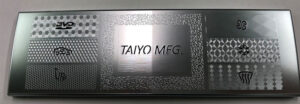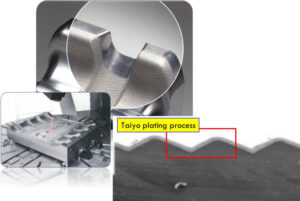by Paul Uglum, president, Uglum Consulting, LLC
A working definition for Plastic Decorating could be: The application of in-mold and post-injection molding materials and process to achieve (or impart) aesthetic, performance or functional properties to the finished part. This, of course, also includes plastic formed in other processes and gives quite a range of options. The technologies used include, but are not limited to, surface preparation, coating, printing, embossing, laser marking, laser ablation, plating, vapor deposition, sublimation, flocking and thermal transfers. It is clear that decorating plastic is a complex and ever-expanding ecosystem of materials, technologies and processes that are used to modify the surface of plastic parts to create desired appearances and performance outcomes. Making things more complex, many of the same technologies are used to decorate materials other than plastics. As a result, key information is distributed across may industries and sources.

Most major market segments, from disposable packaging through aerospace and medical, use decorated plastic. The needs of each of these market segments are unique, but the underlying methods and tools are not. The technologies used to create these parts often are common across many market segments. Unfortunately, there is for the most part no one location to look for information on the options available. Industry groups exist for coatings, plating, physical vapor deposition, in-mold processes and many other technologies. Market segment and technology-specific trade magazines, conferences and trade fairs often are useful tools in learning the latest advances.
A few publications (such as Plastics Decorating), organizations (such as the Decoration and Coatings Division of SPE or the In-Mold Decorating Association) and university classes (which are part of a larger plastics degree) look across the options and technologies available in the marketplace. For the most part, manufacturers and users of decorated plastic rely on internal centers of expertise to collect and disseminate appropriate information.
Why decorate plastics?
It is important to understand why plastics are decorated. Knowing the desired outcome allows the selection of the most appropriate technology needed to achieve that outcome. When failures occur, they often are due to inappropriate choices for the application or at the interface of differing technologies and material sets. Plastics are decorated for the following reasons:
- To provide the desired daytime or nighttime color
- For aesthetics – to cover cosmetic variation in molded parts and to provide a common appearance (harmony) across parts in an assembly
- To increase durability by improving wear, UV and chemical protection
- To apply graphics or a design on the part – to communicate information or for aesthetic purpose
- To block or manipulate light for backlit applications or to hide sensors
- To create haptic effects, such as soft feel
- To meet specific customer requirements for gloss, texture or pattern
- And, ever more frequently, to also impart additional functional capability, such as shielding, self-healing or antipathogen functionality.
In the final analysis, the only reason to decorate or modify plastics is to add value. That value can be in the form of function and/or by increasing the desirability of the product to customers.
Skills needed for success
How knowledge about plastic decoration is acquired and transferred is the key to success. It is important because the environment is not static. Many outside pressures, as well as the development of new technical solutions, create an ever-changing set of options. Even if the current decorating solution is working acceptably today, it may not work well in the future.
In order to be successful in either specifying or creating decorated plastics, a wide set of skills and expertise is needed. In plastic decorating, successful internal centers of expertise include many professions: industrial design, mechanical engineering, chemistry, color science, materials engineering, manufacturing engineering, quality and reliability engineering all have important contributions to make.
Since there are only a few organizations and classes that look at the variety of options, developing an understanding of what is available and appropriate is critical. The first step, though, is understanding the market, consumer preferences, product needs and regulatory requirements. This provides both direction and an understanding of the constraints in designing and manufacturing for the target market. For product designers, it is important to understand the options and limits for each technology. These are best documented in design standards and bills of process.
Designers also must understand what happens when technologies are combined, such as pad printing and painting. Materials suppliers often do not have a complete understanding of how their products will perform in all possible combinations. An example of this is the various ways pad printing has been used with other processes. There are many more interfaces than just the pad print to plastic, and each has a potential for failure if not designed properly.
Avoidable errors
Due to constraints on time – and sometimes lack of training – there is a tendency to copy previous design decisions. This cut-and-paste option can lead to the repetition of past mistakes or, equally likely, the use of successful solutions with an application where they are not appropriate. Neither of these are desirable. Robust peer reviews often are the best way to catch and correct these easily made mistakes and can be completed before any parts are produced and tested.
What is new, and where to find it?
A number of years ago, a consultant named Ed Crutchley spent several years looking at all of the patents issued related to plastic decoration. The result was a book – “Innovation Trends in Plastic Decoration and Surface Treatment.” It provides an interesting picture of the state of technology at that time. Unfortunately, while innovation and invention have continued, the work of documenting them has not. Crutchley divided the key innovations into clusters to watch for: Cost reduction, quality and durability and decorative impact. In today’s environment, “functionality” should be added to the key clusters because decorative technologies can provide added value through the addition of properties ranging from antibacterial to self-healing. Some of these are due to the use of smart materials and others through innovative design integrating additional capabilities into the decorated surface.
The best drivers of innovation are new needs, either in performance or function; the replacement of older, less efficient technologies and thereby achieving cost savings and waste reduction; or providing capabilities and features previously not available. Innovation also does not usually happen all at once but is driven by current needs and the stepwise advances in available technologies. The best innovations come from inspiration driven by need and supported by a foundation of hard work.

Taiyo’s textured chrome required both advances in laser q switch frequencies, which allowed unique and reproducible textures to be applied to plastic molds, and the development of a process to allow even plating on an uneven surface. The result is a very sophisticated chromed appearance (Figure 1).
Current areas to watch are the material developments in both inks and paints. These are a response to changing regulation, as well as market needs for better performance. UV dual-cure developments are continuing to offer more options and improved performance.
Reduction in waste is a common theme in recent advances. ACTEGA recently launched a product called Signite™, a decorated label matrix that provides a 50% reduction in waste and that may improve recyclability in PET applications. ABB introduced PixelPaint, winner of the innovation and entrepreneurship in robotic and automation award, which achieved a two-tone appearance with virtually zero waste. In many ways, it is similar to a system Durr has and to a concept shown a few years ago at NPE with an end-of-arm inkjet head printing parts as they were removed from the tool at the press.
The increase in additive manufacturing is driving the desire to use more of these parts as decorated surfaces. The 3D printed plastic has a different set of constraints and issues than the typical molded part. Most of these are related to the surface preparation and include bead blasting, de-powdering and solvent- or vapor-fusing of the surface. As with any application, it is important to verify that the decorating process and materials are compatible with the surface being decorated.
There are many more advances. Take the time to research and become aware of what is new and what potentially will add value. Learning needs to be continuous and use all available sources of information.
What drives change?
There are many drivers of change. As a result, situational awareness of the trends and requirements is important in making good decisions. Outside pressures, as well as the development of new technical solutions, create opportunities and risk.
Increased public awareness, growing anti-plastic consumer sentiment and globally increasing anti-plastic regulation elevate the importance of a move toward a circular economy – or, at the very least, a less wasteful economy. To make good decisions, a true-life cycle impact assessment is needed to look at the actual energy and resource impacts of proposed changes. What appears to be the right solution actually can have a larger negative impact. Sustainability is not just about materials, but also manufacturing processes and energy usage.
Plastic decoration choices should consider reduction of waste in processes and its impact on end-of-life recyclability. The use of biopolymers as an alternative to traditional polymers means there is a new set of substrates to consider in process and material design.
It is important to note that the use of reprocessed or re-compounded polymers provides an increased risk to decoration processes. Reprocessed materials often are compounded to have the same melt properties and physical properties, such as tensile strength. They, however, have a wider variation in the actual formulation and that can lead to problems, such as read through, when coating them. Care should be taken to look at several batches when validating these materials and performance should be closely monitored over time.
The use environment for products always is changing. COVID-19, for example, has resulted in increased cleaning and exposure to more aggressive cleaning chemicals, as well as various UV-C sources which are known to damage pigments and polymers. Both the plastic and the applied decoration are at greater risk for damage because of this.
One other impact of COVID-19 has been supply chain interruptions. This increases the risk of unapproved substitutions and of manufacturing delays. If cost-effective solutions can be found, this may lead to more reshoring.
The worst driver of change can be government regulation. Bureaucrats and politicians come up with less elegant solutions or are driven by political expedience rather than a careful analysis of unintended consequences. Still, regulations have gone a long way to improve public safety. It is important to be aware of regulations that impact plastic decoration, such as REACH (Regulation Evaluation Authorization of Chemicals) in Europe and the Toxic Substances Control Act (2016 reform) in the United States. For products sold in other countries and regions, it is important to understand the regulations specific to each region before design and material choices are made.
Adopting a new technology
Successful implementation starts with understanding the changes to be made. Failure modes tend to follow the technology. When technologies change, the potential strengths and weaknesses will be changing. Take time to understand them.
Whether introducing a technology that is new to the product or one that is newly available in the marketplace, the first step is to confirm that the business case is sound. When designing in a new technology, it is useful to follow a structured process that documents and verifies the design standards (limits) and performance requirements. Partnering with the materials and part suppliers can significantly reduce risk.
When implementing the new technology in-house, the use of a structured process is critical to success. Again, working with material and equipment partners has a significant impact on success or failure. The development process deliverables should include training development, selection and validation of equipment and tooling, selection of materials, development and validation of the process and design standards, establishment of capable measurement systems to control the process, and making sure the facilities and utilities are adequate for the process. This is not a trivial activity and should be adequately staffed and carefully implemented.
 Paul Uglum has 43 years of experience in various aspects of plastic materials, plastic decoration, joining and failure analysis. He owns Uglum Consulting, LLC, working in the areas of plastic decoration and optical bonding. For more information, send comments and questions to paul.a.uglum@gmail.com.
Paul Uglum has 43 years of experience in various aspects of plastic materials, plastic decoration, joining and failure analysis. He owns Uglum Consulting, LLC, working in the areas of plastic decoration and optical bonding. For more information, send comments and questions to paul.a.uglum@gmail.com.


